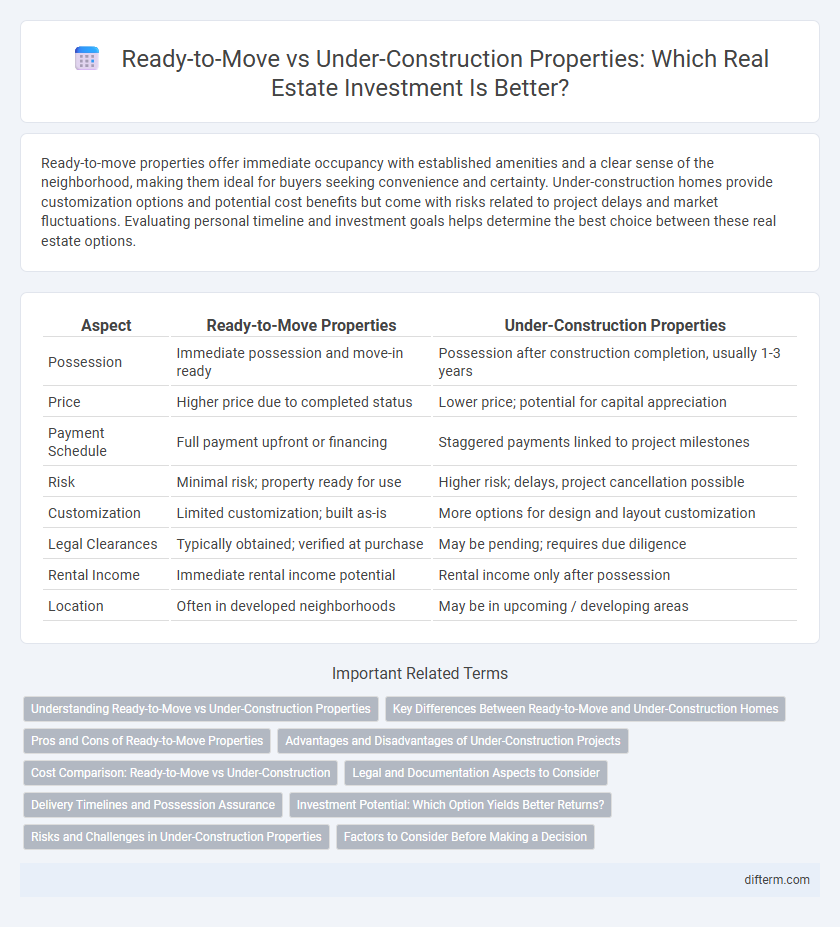Ready-to-move properties offer immediate occupancy with established amenities and a clear sense of the neighborhood, making them ideal for buyers seeking convenience and certainty. Under-construction homes provide customization options and potential cost benefits but come with risks related to project delays and market fluctuations. Evaluating personal timeline and investment goals helps determine the best choice between these real estate options.
Table of Comparison
| Aspect | Ready-to-Move Properties | Under-Construction Properties |
|---|---|---|
| Possession | Immediate possession and move-in ready | Possession after construction completion, usually 1-3 years |
| Price | Higher price due to completed status | Lower price; potential for capital appreciation |
| Payment Schedule | Full payment upfront or financing | Staggered payments linked to project milestones |
| Risk | Minimal risk; property ready for use | Higher risk; delays, project cancellation possible |
| Customization | Limited customization; built as-is | More options for design and layout customization |
| Legal Clearances | Typically obtained; verified at purchase | May be pending; requires due diligence |
| Rental Income | Immediate rental income potential | Rental income only after possession |
| Location | Often in developed neighborhoods | May be in upcoming / developing areas |
Understanding Ready-to-Move vs Under-Construction Properties
Ready-to-move properties offer immediate possession and typically have completed construction, making them ideal for buyers seeking quick habitation or rental income. Under-construction properties often come at a lower price point and provide opportunities for customization but carry risks related to project delays and regulatory approvals. Evaluating factors like financing options, market trends, and builder reputation is essential when choosing between ready-to-move and under-construction real estate investments.
Key Differences Between Ready-to-Move and Under-Construction Homes
Ready-to-move homes offer immediate possession and eliminate the uncertainty of construction delays, making them ideal for buyers seeking quick relocation. Under-construction properties typically provide lower prices and flexible payment plans, attracting investors and budget-conscious buyers willing to wait for project completion. The legal clearance and amenities availability are generally assured in ready-to-move properties, whereas under-construction homes may pose risks related to project approvals and future infrastructure development.
Pros and Cons of Ready-to-Move Properties
Ready-to-move properties offer immediate occupancy, eliminating waiting times and allowing buyers to assess the actual condition and quality of construction before purchase. These properties often come with developed infrastructures such as established neighborhoods, nearby amenities, and clear legal titles, reducing risks associated with under-construction developments. However, ready-to-move homes tend to have higher price points and limited customization options compared to under-construction properties that offer flexible payment plans and potential price appreciation over time.
Advantages and Disadvantages of Under-Construction Projects
Under-construction real estate projects offer buyers the advantage of lower prices and flexible payment plans, enabling cost savings and phased investment. However, they carry risks such as project delays, uncertainties in construction quality, and potential changes in market conditions, which can impact overall returns and possession timelines. Investors must carefully evaluate builder credibility, project specifications, and regulatory approvals to mitigate these disadvantages and secure their investment.
Cost Comparison: Ready-to-Move vs Under-Construction
Ready-to-move properties typically have higher initial costs due to their completed status, but they often avoid additional expenses like extended loan interest or price escalations common in under-construction projects. Under-construction properties generally offer lower entry prices with flexible payment plans, but buyers risk cost overruns and potential delays, impacting the total investment. Evaluating the cost differences requires considering factors such as market trends, project credibility, and financing terms to determine overall affordability.
Legal and Documentation Aspects to Consider
Ready-to-move properties offer complete legal documentation, including sale deeds, occupancy certificates, and clear titles, minimizing risks related to possession and ownership disputes. Under-construction projects require thorough verification of approvals such as building permits, RERA registration, and sanctioned layouts to ensure compliance with regulatory norms and safeguard buyer interests. Legal due diligence in both cases is crucial to avoid fraudulent deals and secure transparent property transactions.
Delivery Timelines and Possession Assurance
Ready-to-move properties offer immediate possession with established infrastructure, eliminating uncertainties linked to project delays. Under-construction projects provide the advantage of customizable options but carry risks of extended delivery timelines due to regulatory approvals or construction setbacks. Buyers prioritizing possession assurance often prefer ready properties to avoid uncertainties related to delivery schedules and possession dates.
Investment Potential: Which Option Yields Better Returns?
Ready-to-move properties offer immediate possession and rental income, making them ideal for investors seeking quick returns and lower risk. Under-construction projects often provide lower entry prices and higher appreciation potential but carry risks related to delays and market fluctuations. Evaluating local market trends, builder credibility, and project timelines is crucial to maximizing investment returns in either option.
Risks and Challenges in Under-Construction Properties
Under-construction properties carry inherent risks such as project delays, quality uncertainties, and potential changes in regulatory approvals that can significantly impact completion timelines. Buyers face challenges including the lack of immediate possession, fluctuating price trends during construction, and the financial strain of extended payment schedules. Legal disputes and developer insolvency add layers of complexity, necessitating thorough due diligence before investing in under-construction real estate.
Factors to Consider Before Making a Decision
Evaluate location stability, possession timelines, and pricing when choosing between ready-to-move and under-construction properties; ready-to-move homes offer immediate possession and often higher costs, while under-construction projects may provide flexible payment plans but carry construction delays risks. Assess the developer's reputation and project approval status to mitigate legal and quality concerns. Consider personal financial readiness, investment horizon, and market trends impacting property appreciation before making a final decision.
Ready-to-Move vs Under-Construction Infographic

 difterm.com
difterm.com